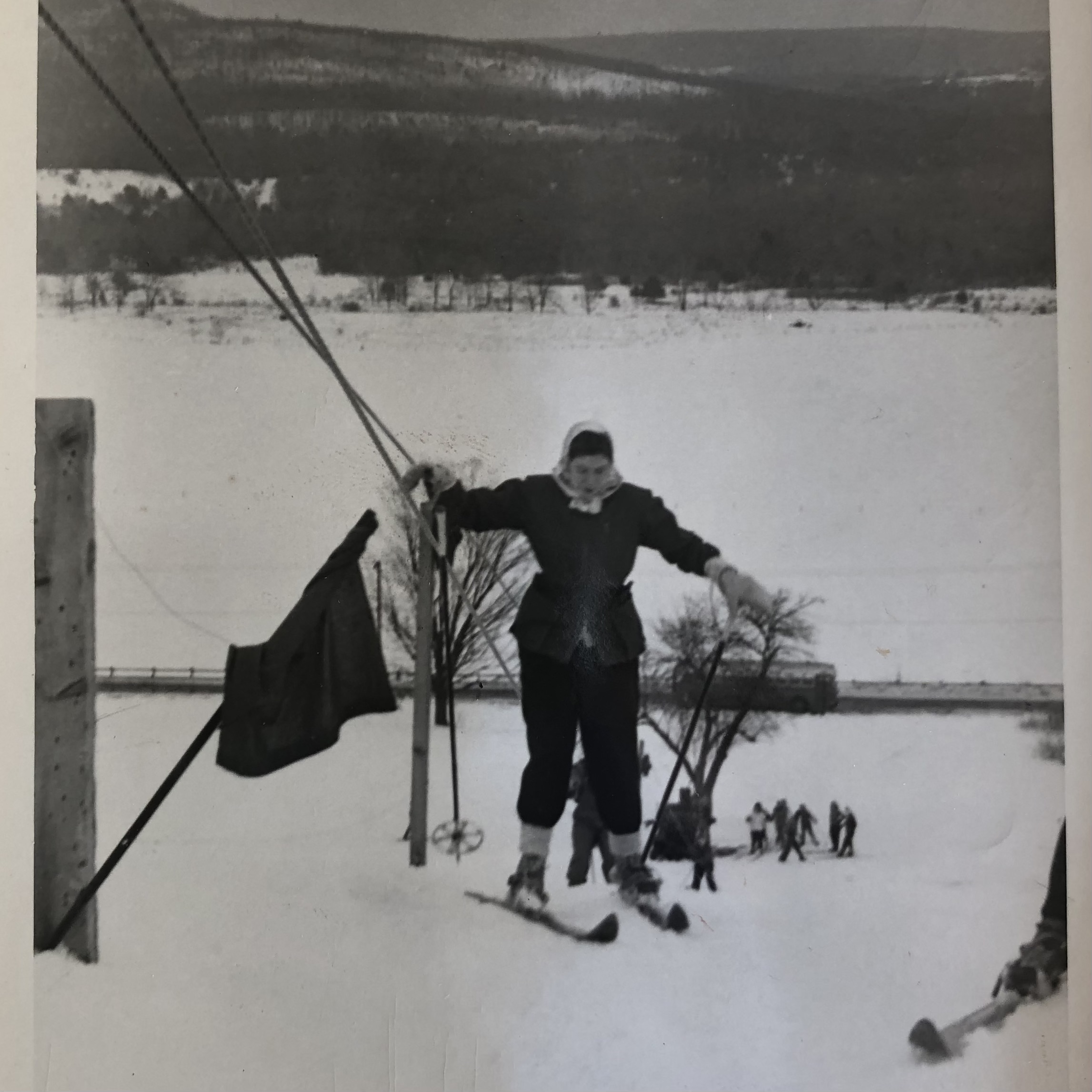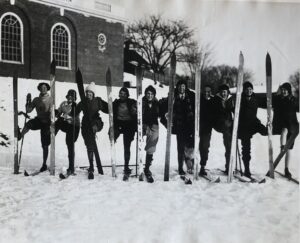
Photo of Smithies holding up one ski behind Scott Gym. Athletic Subject Files. CA-MS-00167, Box 1368. Smith College Archives.
A Very Brief History of Skiing
As a competitive or recreational sport, skiing is incredibly new to the game. Skis were originally created as a means of survival, with the earliest ski artifacts being found in northern Russia circa 6000 BC [1]. However, modern skiing (what we typically think of as cross country skiing: a type of skiing popularized on flat ground and gentle hills) was only birthed around 1850 when Norwegian legend Sondre Norheim popularized skis with curved sides, bindings with stiff heel bands made of willow, as well as the Telemark and Christiania (slalom) turns [2]. From there, skiing took nearly a century to become popularized in the United States– a country that was primed for the arrival of winter recreational sports after WWII.
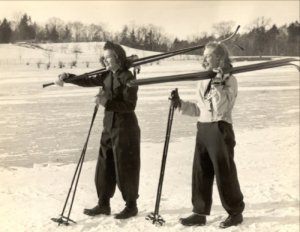
Smith College students carrying skis, 1940. Athletic Subject Files. CA-MS-00167, Box 1368. Smith College Archives.
In the early 1930s, the number of skiers in the United States doubled to an estimated one million skiers in 1936.[3] During this time, skiing was still a sport of firsts. Faster, longer, lighter skis were being developed. Skiing techniques were being invented and disseminated from the Alps in Europe to cozy New England Towns. And most importantly, the technology used to pull skiers up the mountain was just being developed. All of these components helped to commercialize skiing and make it more leisurely.
However, just like other leisure sports, skiing was incredibly male-dominated, practically all-white, and usually only for the wealthy elite. It’s a sport that was primed to become popular at a primarily white institution for wealthier families, like Smith College, during the mid-20th century. However, due their economic privilege, Smith students are able to subvert gender norms and truly succeed in a male-dominated sport. Many students at Smith owned their own skis and paid for skiing lessons with some of the best instructors on the skiing circuit at the time. The image above, taken in 1940, shows two Smith students carrying their skis, most likely on their way to Hospital Hill. Notice what the students in the photo are wearing and the equipment they are carrying. Do you think this style of dress is well-made? How do you think they feel? What do you notice about the landscape?
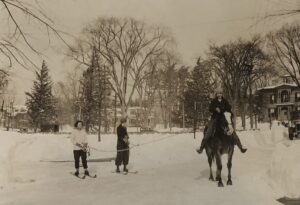
Three Smith students skijoring in Northampton, MA, 1931. Athletic Subject Files. CA-MS-00167, Box 1368. Smith College Archives.
Two Types of Skiing (Or Three If You Include A Horse!)
There are essentially two types of skiing being developed in the mid-20th century: cross country and alpine.
Cross Country: This is a form of skiing where skiers rely on their own locomotion to move across the snowy, relatively flat terrain.[4]
Cross country skiers propel themselves forwards using narrow skis with boots that can be raised off the ski at the heel when striding. This form of skiing is how Smithies got to class. It was not only practical in the snowy New England winters but it was a popular fashion statement. In 1936, one newspaper reported that:
“skiing has invaded Smith with the same rapidity that it has swept the rest of the country”
Almost every girl owned a pair of skis and they lined the porches of each Smith House. In addition, the newspaper notes that ski boots and suits are popular fashions for classes. Imagine yourself in class and what that would look like. The very first photo you saw in this exhibit was of six women cross country skiing at Smith in 1938.
Alpine or downhill: This type of skiing requires gravity to pull you down a slope as you make turns and various maneuvers to control your speed. [5]
Downhill skiing requires a way to get up a hill such as a tow-rope (a motor-driven conveyor that is used for pulling skiers up a slope) or a chairlift (a continuously circulating steel wire rope loop strung between two end terminals and usually over intermediate towers, carrying a series of chairs). These skis are heavier, wider, and less flexible and require your entire foot from toe to heel to be bound to the ski.
Downhill skiing attracted adventurous, thrill-seeking Smithies who frequently skied on Hospital Hill which they called “Dippy” Hill. They also ventured out to other New England mountains with other college ski clubs.
Bonus type of skiing– Ski-joring!
Ski-joring: This is a winter sport in which a person on skis is pulled by a horse, a dog (or dogs), another animal, or more recently, a motor vehicle.[6]
The three photos above show three Smith students ski-joring with a horse! This set up is atypical as usually there is only one skier behind the horse. As you can see, the rider is controlling the horse using reigns and the two Smithies behind hold ropes in a manner that is similar to water skiing. This type of skiing is less common these days, but back in the 1930s, it was a perfect activity to have some fun with some friends.
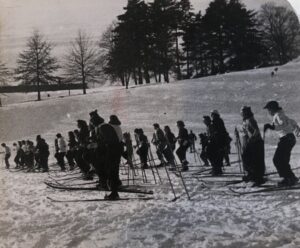
Ski class section on Hospital “Dippy” Hill, 1938. Athletic Subject Files. CA-MS-00167, Box 1368. Smith College Archives.
But How Do You Learn How To Ski AT SMITH IN The Mid-20th Century?
Skiing instruction courses were one of Smiths most popular physical education courses. These courses covered subjects such as which equipment to choose, the history of the sport, current items of interest, organizations such as the NSPS, NSA and USEASA, and local New England resort logistics. In addition to time in the classroom, students also had both “dry training” and on snow instruction. Since classes started in the fall, students worked on “dry training” which consisted of various conditioning exercises as well as taking walks in the local landscape. When snow did fall, students transition to on-ski exercises where they put the Arlberg technique that they learned in the classroom into practice. The Arlberg technique was developed by Hans Schenider in 1924 [7] and due to the influence of instructors like Roland Peabody, this became the primary method taught at Smith College.
“Smith girls are superior in skiing ability to most beginners”– Roland Peabody, an instructor at the famous Hannes Schneider school in St. Anton am Arlberg
Not many other women’s colleges at the time had such highly technical ski classes. Due to Smith’s northern location in Northampton, MA, Smithies could take advantage of the New England weather and jump wholeheartedly into the snow to escape their cabin fever… and also blow some stress off during exam weeks. The photo above shows a large class at Smith learning to ski on Hospital Hill in 1938.
Smith students have always strived to be the best and their history in skiing shows the same pioneering attitude they have always had in the classroom. As very curious, determined young women, Smithies gravitated to skiing and since many students came from wealthier families, they could afford to partake in the leisure sport and consume ski culture. As a college, Smith was on the pulse of this culture and the campus’ location in Northampton, MA meant that they were primed to hop onto their skis and escape their academic worries with a little disciplined fun.
Footnotes:
[1] https://www.freethepowder.com/pages/history-of-skiing#:~:text=%2D6300%20BC%3A%20The%20oldest%20set,wooden%20skis%20and%20sled%20runners%2D%20.
[2] https://www.mountaineers.org/blog/did-you-know-ski-equipment-of-the-1930s#:~:text=The%20number%20of%20skiers%20doubled,today%20began%20to%20take%20shape.
[3] https://skiinghistory.org/gallery/1930s-unexpected-blossoming-alpine-skiing
[4] https://www.dictionary.com/browse/cross-country-skiing
[5] http://href=”https://www.dictionary.com/browse/downhill-skiing”>https://www.dictionary.com/browse/downhill-skiing
[6] http://href=”https://www.thrillist.com/travel/nation/what-is-skijoring-dog-winter-sport”>https://www.thrillist.com/travel/nation/what-is-skijoring-dog-winter-sport
[7] https://www.britannica.com/biography/Hannes-Schneider#ref225327
